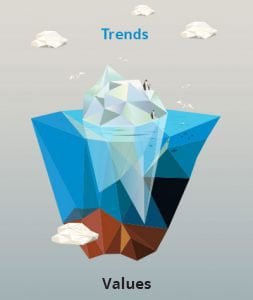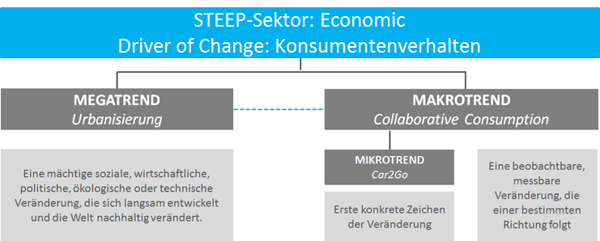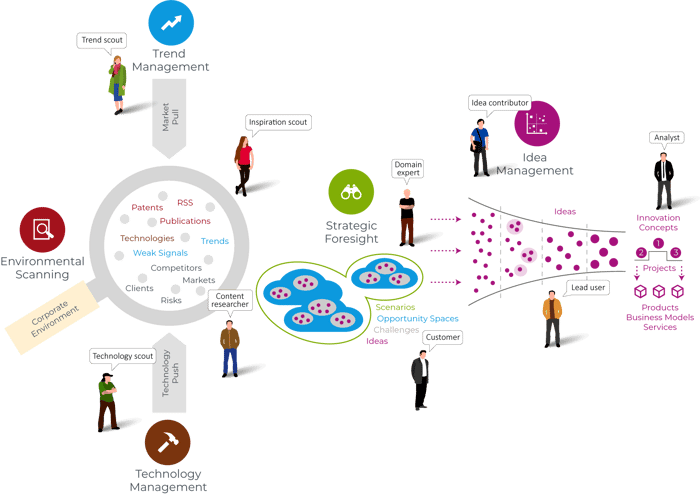Change is the new normal. Evolving markets, new requirements, standards and values, and ever-shorter product life cycles demand a high degree of adaptability from companies.
Companies that can quickly identify changes and even weak signals in their environment and react to them before the competition does will gain a decisive competitive edge (Pillkahn, 2007). However, given the complexity and the fast pace of their market environment, companies are in many cases no longer able to understand it in sufficient detail.
Given the flood of information, it is becoming increasingly difficult to actually identify relevant changes. As a result, companies are forced to react with short-term solutions instead of acting with foresight in their ecosystem. (See also: Why you should care about Trend, Technology, and Startup Scouting)
We cannot predict the future. From the companies' point of view, it is nevertheless essential to identify, interpret, understand, and react to the relevant signals or disruptions in their environment at an early stage. In summary, it is important to know when, where, and how which trend will occur.
→ Free Download: Guideline for identifying Innovation Opportunities
What is a Trend?
A trend is an observable change or development toward something new or different. To understand the impact of a trend on the business environment, companies need to determine the strength of the change and its timing.
So-called "weak signals" are the first signs of change. According to Ansoff (1975), there are different states of signals. The signal strength increases the more we know about the context from which it emerged. In this context, weak signals refer to the simple observation of discontinuities or changes. You notice something, but you don't know what it means or where it comes from. Once you understand the forces that led to the change, its evolution over time, and the direction of change, the weak signal becomes stronger and leads to an observable trend.
On the other hand, hypes are collective and often spontaneous fads that disappear after a short period of time.
The Tip of the Iceberg

Figure 1: Iceberg model
The "iceberg model" of Buck et al. (1998) follows a similar logic. In this model, trends are merely the visible tip of a much larger underlying pyramid of values. This very descriptive representation shows that trends are the result of hidden shifts in values caused by new - often unconsciously emerging - needs, fears, motives or feelings (Buck et al., 1998; Horx, 2010; Liebl & Hermann, 1996).
More specifically, the difference between weak signals, hypes, and trends is how much you know about the size of the iceberg and the forces acting on it below the waterline. If the invisible part of the iceberg is very small, it is more likely to be a hype that will quickly disappear. By observing a trend with a solid foundation and understanding the forces that led to its creation, we can a) assess whether and how long the trend will last and b) understand why we are observing it.
Linking this approach with the trend hierarchy - consisting of mega-, macro-, and microtrends - results in a differentiated picture of the iceberg model.

Figure 2: Trend hierarchy
A fad or hype is therefore the observation of an iceberg tip without a foundation or the observation of a trend without an underlying hierarchy. This observation is of limited duration and therefore has no significance for corporate strategy. However, if we can repeatedly observe new microtrends emanating from an overarching macrotrend, and if this macro trend is based on an existing megatrend, we can rightly assume that these trends will reinforce each other. Under certain circumstances, this can permanently change markets and business models.
| Description | Effect duration | Scope | Examples | |
| Megatrends | Major social, economic, political, environmental or technological changes | 25-30 years | Impacts all areas of life worldwide | Urbanization Climate change Digitalization Individualization |
| Macrotrends | Observable changes pointing into a specific direction | 5-10 years | Widespread, but not necessarily affecting all actors and regions | Shopper-tainment Quantified self Collaborative consumption Cybercrime |
| Microtrends | First concrete signs of emerging trends | 3-5 years | Frequently limited to certain regions and markets |
Bicycle culture |
Figure 3: Megatrends, macrotrends, and microtrends
How to Get from Trends to Strategic Fields of Innovation
Being able to identify changes and assess their relevance for a company, you need a systematic approach in the framework of holistic trend management. The goal is to identify, describe, and rate trends. Furthermore, companies need to document the trend knowledge and derive strategic fields of innovation for corporate innovation management.

Figure 4: Trend management process (following Durst et al., 2010 and Köpernik, 2009)
Understanding trends and their manifestations form the basis for trend management that is "fit for evolution" and thus in turn lays the foundation for targeted growth and innovation. One of the key tasks of trend management is the structured documentation of trend knowledge. Without continuous documentation, it is not possible to store and update trend knowledge and make it available for corporate innovation management.
The existing literature shows that the concepts used for trend management are already established. The picture is more differentiated when looking at the trend management process. In the phases "definition of information sources", "trend research and identification" and "trend evaluation", the existing literature already offers a well-founded set of methods. For trend description or documentation as well as trend visualization and communication, approaches and methods from practice are identified more frequently. In addition, best practices show that dedicated trend management software accelerates the trend management process, integrates the individual phases, and offers problem-solving potential for any identified weaknesses.
For a detailed description of the individual phases of trend management, you can download our whitepaper.











